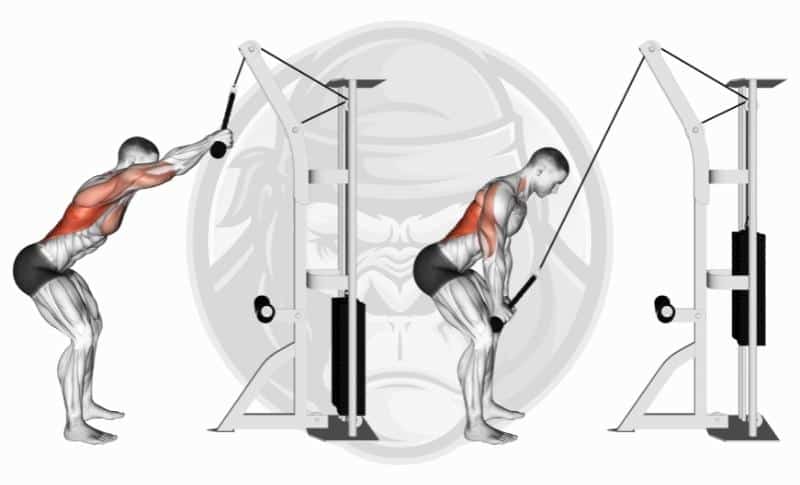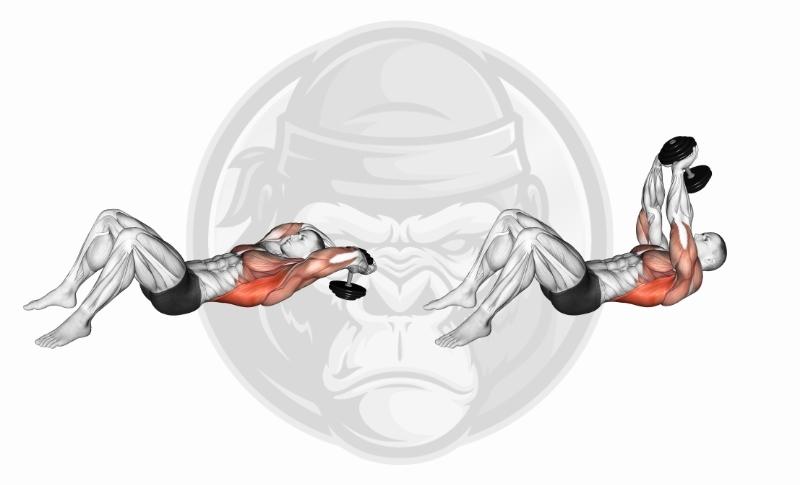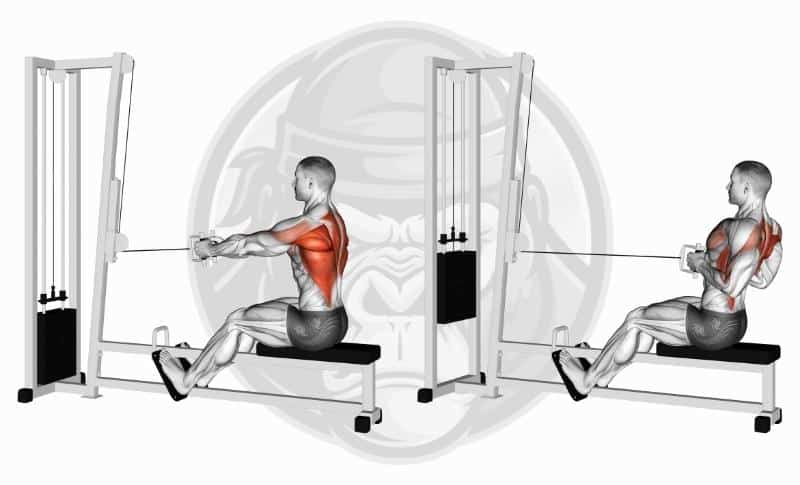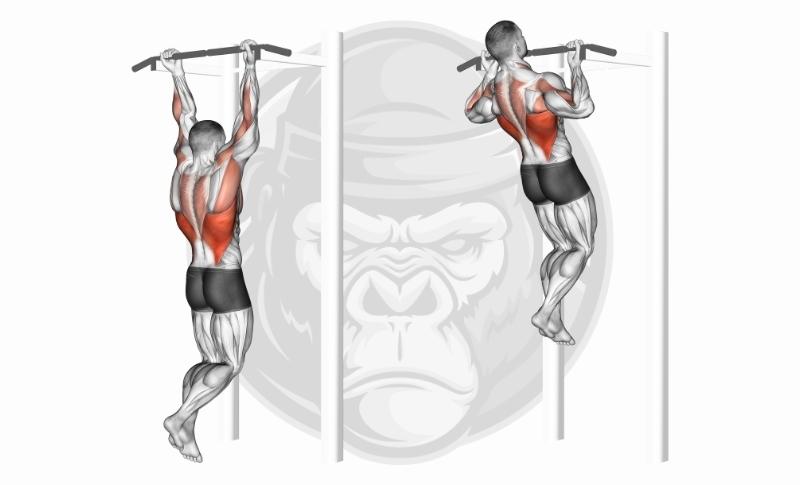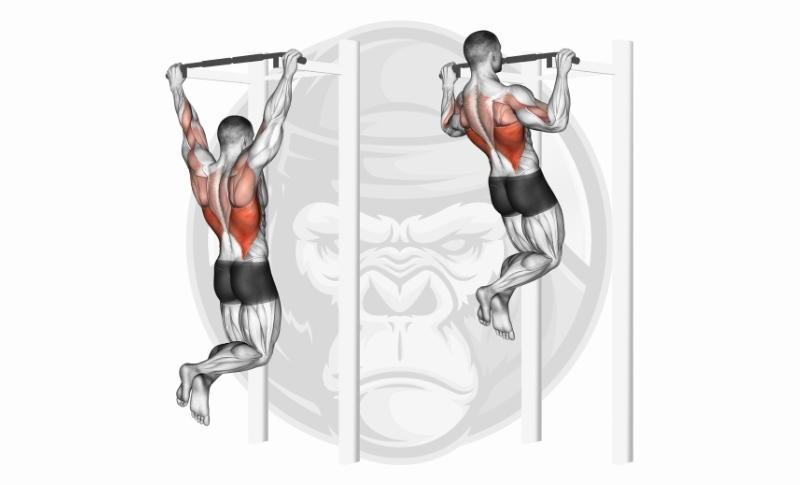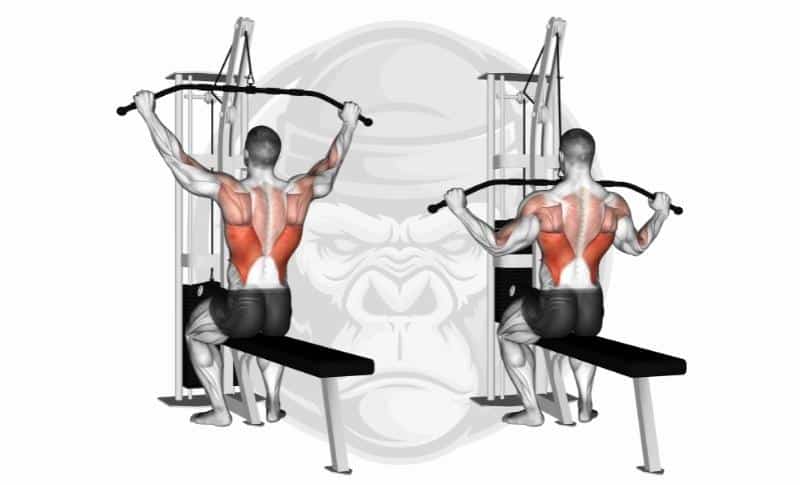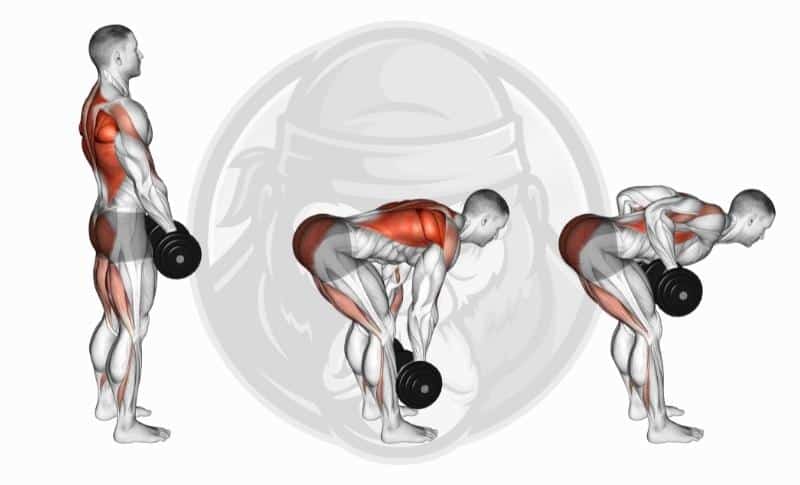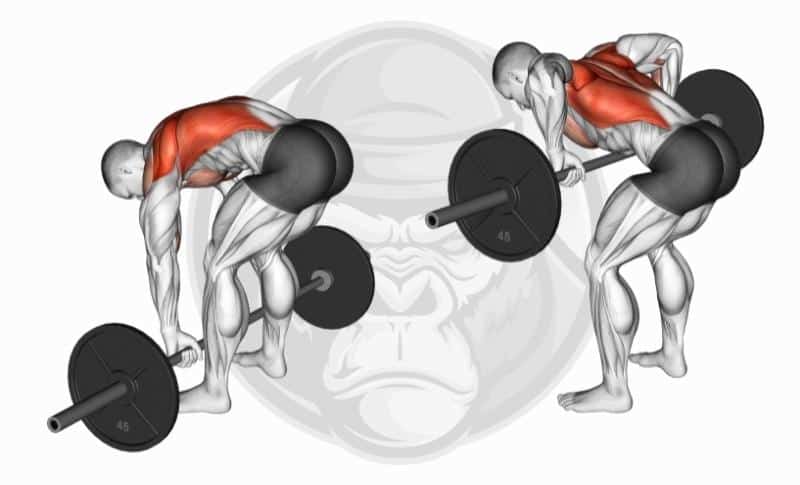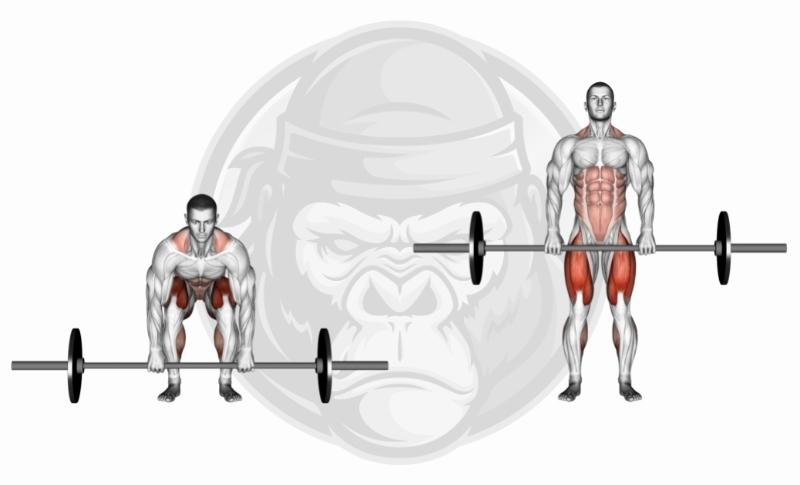Training
The 10 Best Lat Exercises
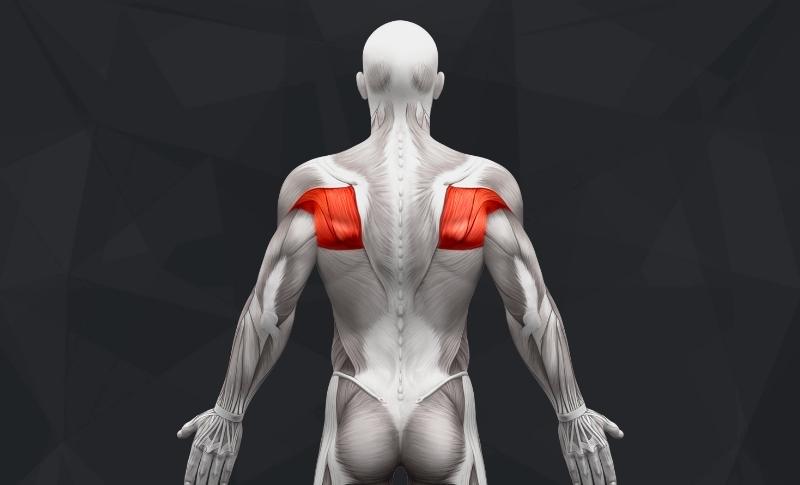
What are the best lat exercises?
Scouring the web for the best lat exercises to build a massive, ripped back? You’ve hit the jackpot with this post!
The lats muscle, or the latissimus dorsi, happens to be the largest muscle in the upper body.
Having strong lat muscles helps during exercises, including swimming, pull-ups, chin-ups, and pulldowns.
Exercises for lats are pretty straightforward and will help you strengthen and sculpt the widest muscle in your back and achieve optimal results along the way.
Read on for some of the best lat workouts you can do to get the back muscles you’ve always wanted.
The Best Lat Exercises
Our exercise lists are created by determining the best exercises for muscle growth, core strength, and overall health and well-being.
Here’s our list of the 10 best lat exercises:
10. Landmine Rows
Great for:
An anchored lats workout that burns and sculpts the back.
How to do it:
- Place your barbell in a landmine
- Select your weight plate for the other end of the barbell
- Grip the handles of the V-bar handle attached to the weighted end
- Align your torso with the floor at 45 degrees
- Perform a row by lifting the weighted end of the bar towards your chest, and pause
- Repeat as desired
Why:
The support of an anchored barbell means you can really focus on working the lats and any other muscles you’re targeting — you can get a great squeeze in when performing a landmine row, thanks to the balance and support of the anchor.
When:
Perform landmine rows in conjunction with other back exercises once or twice a week.
Make sure you’re focused on technique and engaging other supporting muscle groups before you add weight or increase workout days.
9. Lat Pushdowns
Great for:
Increased range of motion and consistent resistance.
How to do it:
- Stand a few feet away from the lat machine cable, so there’s tension when you grab the bar
- Slightly bend your elbows and knees, and arch your back to activate the lat muscles
- Push the bar towards your hips while keeping your elbows slightly bent
- As the bar reaches your upper thighs, squeeze your back and shoulder blades
- Slowly lift the bar to the starting point
- Repeat as desired
Why:
Pushdowns target nearly every muscle group in the upper body, from the lats, chest, triceps, and biceps.
One movement that targets some of the most dominant muscles in the upper body — what more do you need to know?
Cable extension exercises are beneficial because their movements offer a consistent level of resistance, allowing for maximum strength and muscle development.
When:
If you don’t have a lat machine at home, prioritize lat pushdowns on the days, you’re in the gym.
Pushdowns are a low-impact exercise that won’t add strain to your back or hips and can be completed regularly.
Start with performing pushdowns three times a week, a few sets of 8 to 10 reps, and watch your strength improve quickly within a consistent routine.
8. Dumbbell Pullovers
Great for:
Targeting the lats, chest, and abs.
How to do it:
- Lie facing upwards on a bench, with your legs bent and your feet flat on the floor
- Hold a single dumbbell in both hands above your head
- Lower the dumbbell behind your head, slowly towards the floor
- When you feel your chest tighten and stretch, slowly move the dumbbell back above your head
- Repeat as desired
Why:
Lat exercises that hit two other major muscle groups? Sign us up. That’s precisely what dumbbell pullovers offer, so adding them to any back day is a solid choice.
Lowering the weight over your head towards the floor isolates the lats, making this one of our favorite latissimus dorsi exercises.
When:
If you’re a beginner, start with a weight that feels comfortable lowering over your head. Complete a few reps there, and aim to do two or three sets of 8 reps total.
We’re big fans of the dumbbell pullover because all you need is a bench and a dumbbell; they can be performed in a small space or with minimal equipment, and you’ll still get a great lift in.
7. Seated Cable Rows
Great for:
A versatile compound exercise that works the back and arms
How to do it:
- Sit on the cable machine and bend your knees, resting your feet flat on the platform
- Pull the handle towards your lower back, bending your elbows and keeping your back straight
- As you row, squeeze your shoulder blades together
- Bring your arms straight back to the starting position; cables should be under tension the whole time you are rowing
- Repeat as desired
Why:
Seated cable rows are a top choice latissimus dorsi exercise due to the pulling movement they offer while simultaneously hitting the biceps and hard-to-hit triceps.
The rowing movement teaches our body to engage the core and keep a strong back while pulling anything towards the chest, from a workout to normal daily activities.
Strong back and core muscles help to prevent strain and injury in and out of the gym.
When:
Weighted cable rows can be performed whenever you’re at the gym, and your back and arm muscles are activated and ready for work.
This exercise is versatile enough that you can complete it during any workout involving the arms, chest, back, or core.
6. Chin-Ups
Great for:
Building definition and strength in the lats, biceps, rear delts, core, and more.
How to do it:
- Hang from a pull-up bar with an underhand (palms facing you) grip with your hands less than shoulder-width apart
- Bend your elbows and pull your chest to the bar
- Hold at that spot, then slowly lower yourself back down
- Repeat as desired
Why:
Chin-ups are an excellent upper body workout because they target a variety of muscle groups without overstraining them individually.
Chin-ups are essential to building strength in the biceps and other muscle groups in the arms and back.
They’re great lat exercises and will have you feeling it after just a few reps. Some claim that chin-ups are easier than pull-ups. Don’t be fooled!
When:
If you are just getting started with chin-ups, there are a lot of great variations you can start with to get accustomed to the exercise and what it requires from your muscles.
Start small, with three to five reps, and go from there.
5. Pull-Ups
Great for:
Targeting all the same muscles as chin-ups, with better grip control.
How to do it:
- Hang from a pull-up bar with an overhand (palms facing outward) grip with your hands shoulder-width apart
- Bend your elbows and pull your chest to the bar
- Hold at that spot, then slowly lower yourself back down
- Repeat as desired
Why:
Pull-ups offer their own set of challenges, particularly because the overhand grip removes the biceps from the equation.
Without the support of the biceps, the lats have to do much more work to pull your body upwards.
For the best workout for the lats, try to widen your grip as much as possible while still effectively completing a pull-up.
The wider the grip, the more isolated the lats are, and the harder they have to work.
When:
To increase strength and muscle size, we recommend taking a rest day after completing a workout that involves pull-ups.
Try for three days a week and re-evaluate after a few weeks of this routine.
4. Lat Pulldowns
Great for:
A clean, simple move to focus on the lat muscles.
How to do it:
- Sit at a lat pulldown machine
- Settle your grip around shoulder-width distance apart
- Engage your core and pull the bar toward your chest, squeezing your shoulder blades
- Keep your core engaged and squeeze your glutes when the bar reaches your chest
- Slowly raise the bar back up to the starting position
- Repeat as desired
Why:
If you’re on the hunt for an isolated lat workout that offers the major benefits that pull-ups do, pulldowns are a clear choice.
Pulldowns isolate the lat muscles, but they also help you break a sweat — by squeezing your glutes and shoulder abs throughout the exercise and keeping your core engaged, it’s a full-body burn.
When:
Pulldowns are commonly used to warm up the lats for other arm and back exercises.
So if you’re a beginner, treating them as a muscle activation warm-up for your lats is a great way to perfect your form and get comfortable using the lat machine.
3. Dumbbell Rows
Great for:
Targeting the lat muscles and the entire back.
How to do it:
- Hold a dumbbell in one hand, your arm hanging at your side
- Engage your core and hinge forward, so your chest is facing the floor
- Rest your free hand on a bench or wall for balance
- Pull the dumbbell slowly upwards towards your ribs, pausing at the top for one second
- Slowly lower the dumbbell back down
- To emphasize the lat muscles, let the dumbbell hang longer at the bottom for a solid stretch
- Repeat as desired
Why:
Targeting the entire back, not just the lat muscles, can be done with dumbbell rows.
They’re a low-impact movement and a great place to start for beginners or those who are still gaining confidence working with weights.
When:
When trained correctly, lat workouts can be done 3 or 4 times a week with minimal soreness or strain.
Dumbbell rows can be added to any back or arms workout routine.
Start with two reps of 8 to 10 reps, and add weight as you feel stronger and balanced.
2. Barbell Rows
Great for:
A versatile move that greatly helps with hypertrophy.
How to do it:
- Stand next to your loaded barbell and bend your knees
- Hinge your hips forward, so your chest is parallel with the ground
- Grab the bar with an overhand grip
- Engage your core and lift the barbell, raising your chest to a 45-degree angle towards the ground
- Bend your elbows and pull the barbell to your chest
- Lower the bar to where you started at step #4. You did 1 rep!
- Repeat as desired
Why:
Rows require the activation of the core, legs, and back to successfully get a solid burn.
Because of this, it’s an essential move in many athletes’ and weightlifters’ repertoire.
Activating so many muscle groups at the same time makes barbell rows one of the most versatile moves you can do for a full-body burn.
It’s one of our favorites, no doubt about it.
When:
You’ll need a barbell and weights to perform this move, so it’s best done at the gym or in a home gym setting.
Because lifting heavy weights can add strain to your back in the hinged rowing position, make sure to start slowly with less than 10 reps per set and add weight as you feel comfortable.
1. Barbell Deadlifts
Great for:
A classic lifting and lowering motion that targets the lat muscles.
How to do it:
- Stand near a loaded barbell, with it touching your shins
- Grab the barbell with an overhand grip, your arms slightly wider than shoulder-width apart
- Place your feet shoulder-width apart
- Bend your knees far enough to grab the bar comfortably
- Stand up slowly and lift the bar with you, pulling your hips back to a standing position
- Lower the bar back down to the floor, pause, and repeat
Why:
While many do deadlifts to target the glutes and hamstrings, the lat muscles are majorly exercised during the lifting and lowering motions.
As the barbell hangs from your arms, your lats have to pull for the move to happen.
It’s a fantastic exercise for your back and lower body and will help build a strong back through consistency.
When:
Because strong lats are essential to lifting heavy and building a foundation of upper body strength, we recommend prioritizing deadlifts in the majority of your strength training workouts.
If you’re new to the deadlift, work on perfecting your form and grip before you worry about increasing weight or reps.
Start with two sets of five to ten reps, and evaluate once you feel confident in your technique and strength.
FAQs About Lat Exercises
Here are the answers to some frequently asked questions about the best lat exercises you can do on training days.
Q: What do the lat muscles do?
The lat muscles power the adduction of the arm at the shoulders, the extension of the arm at the shoulders, and the internal rotation of the arm at the shoulder.
Lats also assist with stabilizing the back as the shoulders extend, protecting the spine during movement like reaching and pulling, and supporting good posture.
Q: Why is it important to train lats?
Lat exercises help strengthen the lat muscles and many other muscles in the back that help with posture, stability, and overall upper body strength.
Lats run from the shoulder across the back and even influence the hips.
Because of this, training the lats is essential to have a strong, stable back, shoulders, and core.
Failing to train the lat muscle often results in overcompensation from other muscles, which can lead to injury.
Q: How many reps should you do for lat pulldowns?
Once you feel confident with your form and technique, performing anywhere from 10 to 15 reps per set should get your lats working.
Increase the intensity by adding weight or pushing for an extra one or two reps per set.
During a lat workout, form is the most important factor; once you’ve got that down, the sky’s the limit.
Q: How often should you work your lats?
We recommend actively working out the lat muscles two to three times a week.
The good news is that the lats are versatile enough that they can be activated through many different exercises, so the lat portion of your back day will never be boring!
Q: What’s the best lat exercise?
The best lat exercises are the ones that are low-impact but give the lat muscles a serious stretch (and burn!) at the same time.
In our humble opinion, the best lat exercise is the barbell deadlift.
The lat isolation that occurs through the hanging motion makes barbell deadlifts a total lat burner and one of our all-time favorite moves.
Summary
Having a jacked back is the goal of many fitness enthusiasts, and it sure takes work to achieve those muscle gains.
While toning and sculpting the lat muscles may not be high on your fitness priority list, this post should solidify how essential lats are to upper body strength and acquiring that particular ‘look’ that weightlifters have.
Don’t neglect this powerful muscle and keep pushing towards those back goals. You can do it!
Here’s a quick recap of the 10 best lat exercises:
- Barbell Deadlifts
- Barbell Rows
- Dumbbell Rows
- Lat Pulldowns
- Pull-Ups
- Chin-Ups
- Seated Cable Rows
- Dumbbell Pullovers
- Lat Pushdowns
- Landmine Rows


